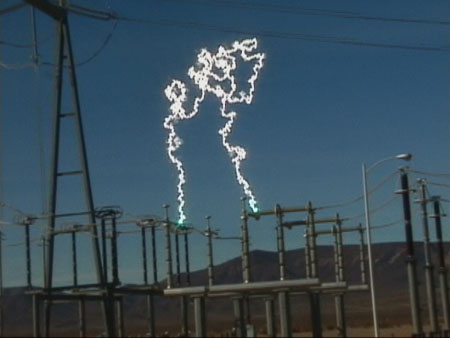

This was sent to back in 2004 and I recently got this update with more details on what caused it - WILD!
This video clip was captured by the maintenance foreman of the 500 kV Eldorado Substation near Boulder City, Nevada. It shows a three-phase motorized air disconnect switcher attempting to open high voltage being supplied to a large three phase shunt line reactor. The line reactor is the huge gray transformer-like object behind the truck at the far right at the end of the clip. Line reactors are large iron core coils (inductors) which are used to counteract the effects of line capacitance on long Extra High Voltage (EHV) transmission lines. Internally, this line reactor has three coils, one for each phase in the three-phase system. Each coil within the reactor can provide 33.3 Million Volt Amperes of compensating inductive reactance (MVAR) at 290 kV between each phase to ground . The power company had previously encountered difficulty interrupting one of the three phases when trying to disconnect the line reactor. The substation maintenance crew set up a special test so that they could videotape the switching event, and they made arrangements to "kill" the experiment, if necessary, by manually tripping upstream circuit breakers.
This particular switcher uses gas filled switching elements, called "gas puffer" interrupters (circuit breakers). These are located just to the right of the rotary air break switches. The actual switching elements of these interrupters are hidden inside the gray horizontal insulators (bushings). The switching elements are housed within sealed "bottles" filled with a special insulating gas (sulfur hexafluoride, SF6) under high pressure. SF6 helps to rapidly extinguish ("quench") the arc that's created when the high voltage circuit is broken. During normal operation, the switcher will first open the SF6 interrupters which disconnects the HV circuit so that the air break switches can open with no current flowing. Once the air break switches completely rotate to the "open" position, the SF6 interrupters then reclose. Normally, this sequence insures that the air break switches operate de-energized and arc free.
These gas puffer interrupters use two SF6 bottles that are connected in series, since it takes two switches to withstand the high voltage stress. In this video, one of the pairs of SF6 interrupters is defective and it fails to open. This places the entire voltage stress across the remaining good interrupter. As the good one valiantly tries to open the inductive load, it creates a high voltage surge that causes the bushing of the good interrupter to flash over. The initial flashover can be seen arcing across the horizontal interrupter bushing at the very beginning of the video clip. Since the affected phase remains energized (through the flashover arc), the air break switch begins to open while still "hot" (energized). It continues arcing as the switch rotates 90 degrees to the fully "open" position. Once the air break switch reaches the fully open position, the SF6 interrupters then reclose. Although this extinguishes the horizontal arc across the good interrupter's bushing, the arc across the air break switch persists, continuing to grow and creating a potentially dangerous situation. The arc stretches upward, driven by rising hot gases and writhing from small air currents, until it easily exceeds 100 feet in length. Switching arcs usually terminate long before reaching this size since they normally flash over to an adjacent phase or to ground. Once this happens, the phase-to-phase fault current will cause an upstream circuit breaker to trip, disconnecting the circuits. A phase-to-phase arc can be seen at the very end of the previous 230 kV air break switch video, just before the resulting short circuit trips upstream Oil Circuit Breakers (OCB). Since the 500 kV arc was in open air and was sufficiently removed from adjacent phases, it could have persisted for quite some time. To avoid risking further damage to their equipment, the utility manually commanded the upstream circuit breakers to open, abruptly extinguishing the arc. After this event, it was determined that both SF6 switch bottles in the affected phase had sustained permanent damage. The bottles were sent back to the manufacturer for analysis to determine the root cause of the problem. Loss of pressurized SF6 gas inside one of the interrupter bottles is suspected as the root cause of the initial switching failure.
As impressive as this huge arc may be, the air break switch was really NOT disconnecting a real load. This arc was "only" carrying the relatively low (about 100 amps) magnetizing current associated with the line reactor. The 94 mile long transmission line associated with the above circuit normally carries over 1,000 megawatts (MW) of power between Boulder City, Nevada (from the generators at Hoover Dam) to the Lugo substation near Los Angeles, California. A break under load conditions (~2,000 amps) would have created a MUCH hotter and extremely destructive arc. Imagine a fat, blindingly blue-white, 100 foot long welding arc that vaporizes the contacts on the air break switch and then works its way back along the feeders, melting and vaporizing them along the way. Still, you've got to admit that this "little" 33 MVAR arc is certainly an awesome sight!
And, who says utility guys don't have any fun - just listen to one of the maintenance crew guys on the right "whoop" at the end of the clip!
The original source for this was Bert Hickman
who graciously said they can be used with permission.
Be sure to check out his awesome web site
at www.teslamania.com.